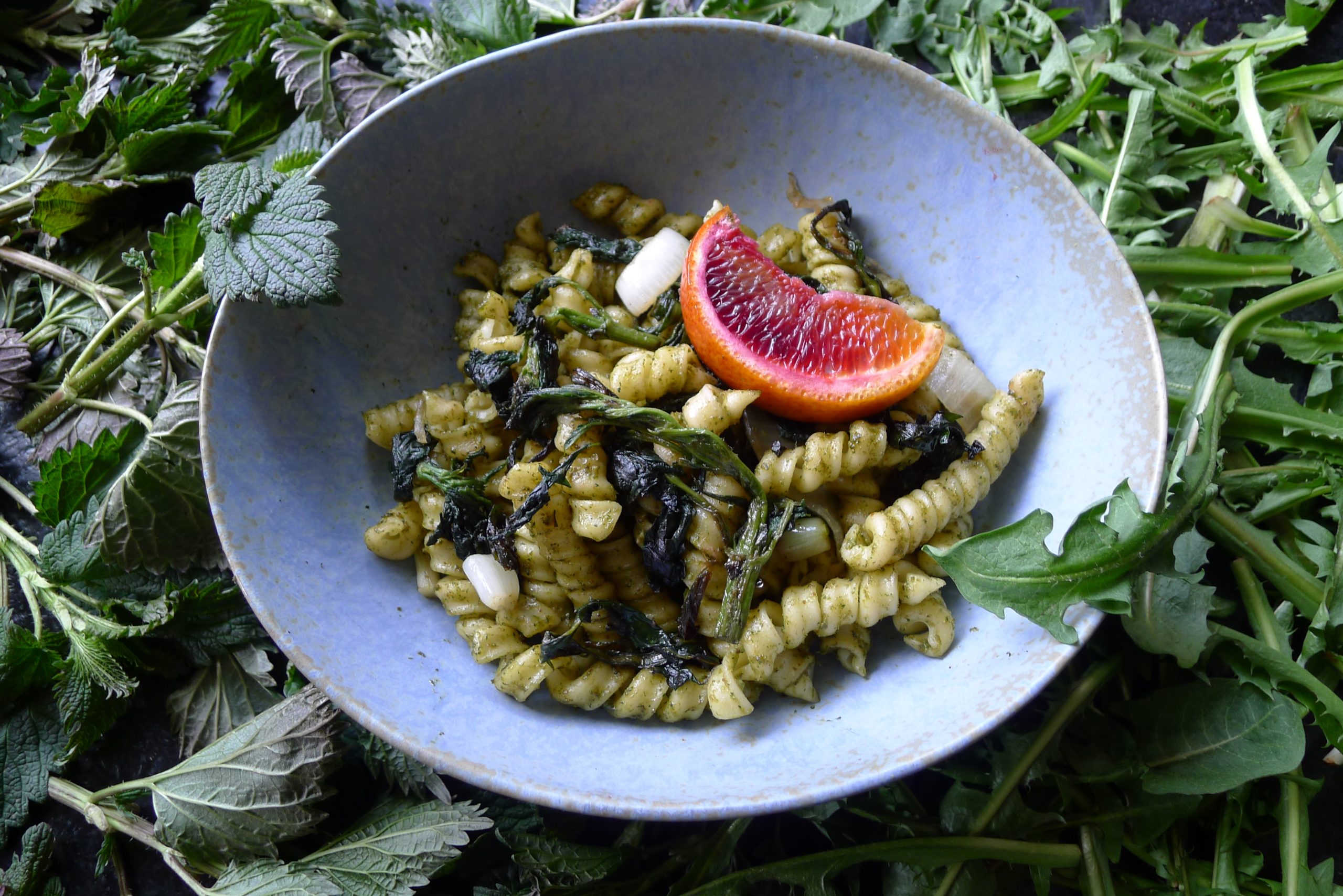
Take a Walk on the Wild Side
The wild greens of springtime are on the rise, in the woods, by the creek, near the tracks, and in your garden, where they are known as weeds. These plants can be intensely bitter and aromatic, making them too strong flavored for many palates. For those who haven’t yet acquired a taste for them, turning these greens into pesto is a great way to explore the wild side of greens.
Pesto is a process as much as a recipe. It’s a method of turning greens into an Italian-style green paste by grinding them with garlic, oil, nuts and cheese. These ingredients, also robust of flavor, can turn the strength of wild flavors into an asset.
Every region will have its own array of edible and nutritious spring greens. I found nettles growing in a little wild spot near my house, and dandelions in the garden. So I decided to make dandelion and nettle pesto. Dandelions are bitter like a fine IPA, but the pesto they make isn’t, because it’s covered up by the other ingredients. Nettles have a fruity, metallic flavor. And thanks to their prickly nature it’s best to harvest nettles with scissors and gloves. The stingers wilt when cooked – and in the case of pesto, when spun in the blender.
This wild pesto is in the spirit of the old fashioned “spring tonic.” A Spring Tonic is a mix of wild plant parts traditionally gathered at the end of winter in many rural parts of America. Back in the day, our pioneering and homesteading predecessors survived the winter on rations that would dwindle to the likes of flour, bacon, potatoes and sugar. When winter finally broke after months indoors on a white, greasy diet, the first hunt of the year for vitamin-rich green shoots was an awakening for the mind, body and belly.
Foraging helps build the relationship between you and your landscape. You look differently at a place when you forage it, and see the landscape more closely, differently, and more deeply. You begin to think ecologically, keeping track of north, south, elevation. You find yourself having thoughts like, “I’m going to be down in the valley this afternoon, where the dandelions will be further along and bigger; I should grab some.” Whether or not you find anything to eat, the very act of exploring vacant lots, river bottoms, random woodlands and other spots will be a reward in itself.
The bitter nature of wild plants is the flavor of both medicine and poison. But if you’ve done your research properly, the bitterness should all be medicinal. Or at the very least, nutritional; wild plants tend to be more nutrient-dense than their domestic counterparts.
Just remember, every would-be forager must assess the grounds at their disposal and strategize accordingly. Always do your harvesting away from any trail, and don’t ever wipe out a location, so that the patch can recover. And if you are lucky enough to have a backyard, explore every square inch. Avoid foraging in dog parks, toxic waste dumps, and close to roads. Just as importantly, remember that the food we gather has not been vetted for edibility like grocery store food. Make sure you know what it is that you are gathering. Nowadays there are apps that can identify plants, or if you’re old fashioned you can use a book. Either way, foraging in the modern age is still foraging. And the wild foods of spring are just as wild as ever.
Wild Pesto
Pesto is one of the tastier ways to consume any strong-flavored green plant. Today’s pesto is made with dandelion and nettles, which makes a thick, aromatic pesto. Feel free to substitute any number of wild greens or weeds, like lambsquarter, watercress or chickweed, or a mixture of whatever you think will go well together. You can also add basil, parsley and other domestic herbs.
8 Servings
2 tablespoons chopped garlic
1 teaspoon salt
1 cup olive oil
1/2 cup almonds (or pine nuts)
½ cup grated parmesan or romano cheese
Zest of a lemon, and 2 tablespoons of juice
4 cup chopped dandelion greens, loosely packed, spotlessly clean
5 three-inch nettle tips (or other greens)
Add the garlic, salt, oil, almonds, cheese, lemon juice and zest to the blender and turn them into a thin, homogenous (and delicious) solution. Carefully add the greens to the pesto, a few at a time, until they too are part of the smooth, green paste.
Serve your weed pesto tossed on piping hot noodles, which will cook the garlic just a tad. I like to stir in some sauteed greens too, for an extra reminder of why we are here.
Refrigerate the leftovers for up to a week, or freeze to store for the year.